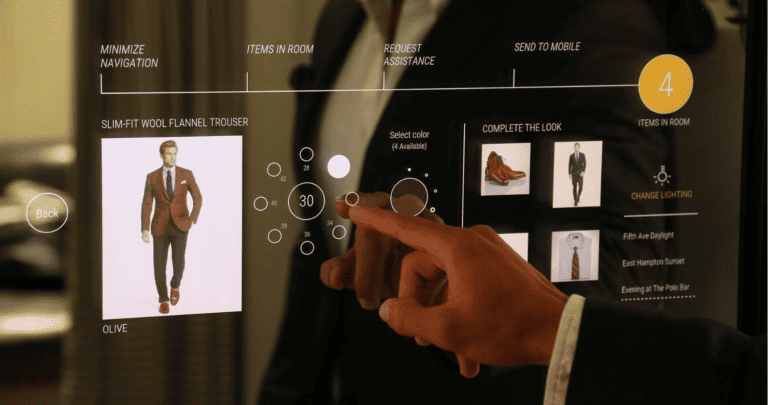What does the future of e-commerce look like? Insights into the future of our shopping patterns
New technologies continue to develop and take their place in our daily lives. Consumption and shopping habits are changing and evolving along with technology. Drive, Click and Collect, e-commerce, virtual fitting, shopping on social networks... So many new things are coming onto the market. But what are the main trends? And how are they being implemented?
The e-commerce market
The pandemic has amplified and encouraged online consumption, which was already gradually becoming part of consumer habits. Selling online has become a mainstay for many brands, and has become indispensable, even necessary, to meet consumer expectations. The fashion sector remains the most popular: clothing, shoes, accessories, etc. Online shopping is winning over more and more Internet users, in particular thanks to its simplicity, speed, fluidity and the complete offer displayed. The quality of customer services and the resources put in place have succeeded in reassuring even the most sceptical customers. Indeed, it is now easy to return a product if it does not fit or even to choose the right size of clothes thanks to the guides provided. The beauty sector and the leisure and games sector are also successful. The retail sector is thus undergoing a real transition and technological transformation.
In terms of figures, 82% of French people now use the Internet on a daily basis. This figure reflects the influence of new technologies in our daily lives. The use of smartphones and social networks (Facebook, Instagram, Twitter...) has become commonplace. They have become the perfect tools for online shopping.
Mixing physical and digital: is it possible?

An ecosystem phygital is therefore developing to take a full place in the brand development system. However, the physical aspect is not left aside and even becomes a strength by combining it with digital. We are seeing the emergence of phygital models mixing physical and digital shops. By expanding the purchasing possibilities and the points of contact, companies are opening up new opportunities for growth. For example, internet users shop via an app on their phone and collect their shopping on time from the shop. They can also pay with their phone and their watch or order in a restaurant using a QR code. A cohabitation between physical and digital touch points is emerging.
Experiences are becoming increasingly customer experience oriented, particularly by offering complementary services. All these tools allow companies to create phygital operations to serve their customers. Numerous advantages appear, such as a saving of time, energy, understanding or even organisation.
Contact
A sustainable model through e-commerce
The pandemic has amplified and encouraged online consumption, which was already gradually becoming part of consumer habits. Selling online has become a mainstay for many brands, and has become indispensable, even necessary, to meet consumer expectations. The fashion sector remains the most popular: clothing, shoes, accessories, etc. Online shopping is winning over more and more Internet users, in particular thanks to its simplicity, speed, fluidity and the complete offer displayed. The quality of customer services and the resources put in place have succeeded in reassuring even the most sceptical customers. Indeed, it is now easy to return a product if it does not fit or even to choose the right size of clothes thanks to the guides provided. The beauty sector and the leisure and games sector are also successful. The retail sector is thus undergoing a real transition and technological transformation.
In terms of figures, 82% of French people now use the Internet on a daily basis. This figure reflects the influence of new technologies in our daily lives. The use of smartphones and social networks (Facebook, Instagram, Twitter...) has become commonplace. They have become the perfect tools for online shopping.

We can then ask ourselves what our future purchasing trends will be. We are already seeing major themes emerge today that will guide the habits of tomorrow. The metaverse is particularly central to current concerns. Numerous events can then be set up within these virtual spaces, such as shopping, for example. This is a new development opportunity for brands to seize, particularly by adapting their digital presence to this new universe.
The augmented reality has also become a major lever of action. Increasingly used by brands, this tool offers a high quality customer experience thanks to a total immersion in the brand's universe. To highlight a new product, service, event or even a brand's environment, it is an effective engagement lever for brands.
On the other hand, the personalisation of products and services has become a major challenge for brands in order to differentiate themselves and offer superior content. With multiple data collection on the Internet, thanks to cookies and others, brands are increasingly able to get closer to and target Internet users according to their interests. Brands can personalise their content and target their potential customers more precisely, a real opportunity.
Finally, a new awareness is emerging, particularly in terms of the way we consume and act. A more responsible consumption model is expected. This is a trend to be taken into account in the proposed content. Consumer trends and technological innovations are evolving and are gradually shaping the purchases of tomorrow. New challenges must therefore be taken into account. Indeed, it is necessary for brands to adapt and evolve.
If you would like information on augmented reality or other topics, please do not hesitate to contact our experts !